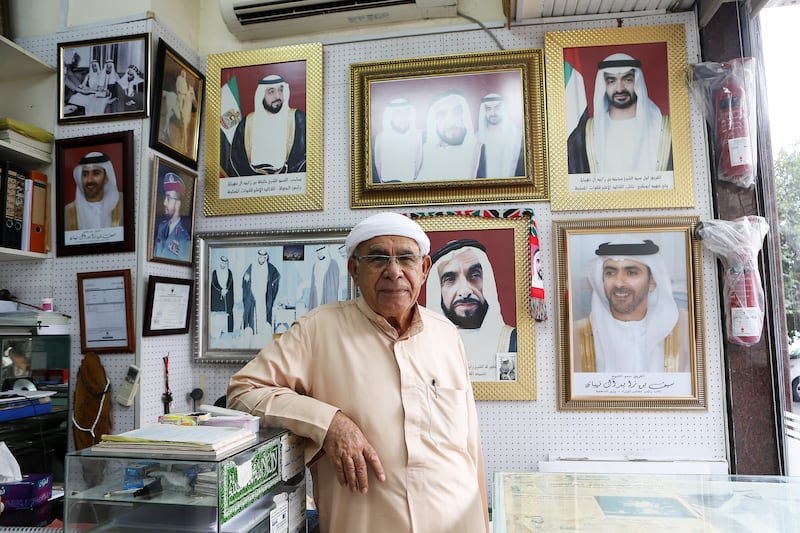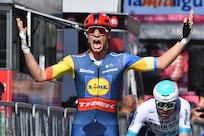Anil Shill named his barber shop Black House Hairdressing Saloon because when he arrived in Abu Dhabi from Bangladesh in 1978, Electra Street was dark. When he opened Black House in 1992, the first thing he did was hang a portrait of the country's Founding President, Sheikh Zayed. This was not because it was fashionable, but because Shill saw it as a fitting tribute to both the development that lit up Electra Street, and the 13 years he had served in the UAE Armed Forces.
Whenever Shill, 61, wants to get a new portrait, he heads to the framers of Electra Street. Their work hangs unnoticed in hundreds of homes and offices across the country. "All people know that framing and glass is on Electra," explains Mostafa Nader Nadderi, who opened Al Ain Frames in 1979. " Hamdan Street was for dress, Electra Street was for frames."
The 70-year-old is one of the frame makers who have been on Electra street since the mid-1970s, most of whom came from Iran more than 50 years ago as teenagers. Nadderi came on a baqara ship in 1963 at the age of 15, earning a rupee a day with room and board at his first job in Dubai. He saved enough to open his own shop in Al Ain before shifting to Electra Street. In those years following the country's 1971 unification, placing royal portraits on office walls quickly became a national habit.
Name a business in the capital, and Nadderi will tell you the work he's done there.
He says he's framed more than 5,000 images of the royal family. Recently, he gave one government department a quotation for 3,000 frames – 1,000 for Sheikh Zayed, 1,000 for Sheikh Khalifa, President of the UAE, and 1,000 for Sheikh Mohammed bin Zayed, Crown Prince of Abu Dhabi and Deputy Supreme Commander of the Armed Forces.
Nadderi offers 47 different photos of the rulers. He acquired these from various sources – from stationary stores to rare photographs bought from Al Ittihad newspaper. Customers can choose from this collection to get their framed photo. The most expensive photo he bought is a Dh700 portrait of the royal family at a majlis. One copy can be seen at a biryani restaurant around the corner.
The framer has photos of his most popular subjects in various settings – from Sheikh Zayed riding a white stallion, to a collage that includes the Founding President bowling.
Styles change. A photo of Sheikh Zayed in aviators was favoured in the late 1990s. Today's best-seller is a composite of Sheikh Zayed, Sheikh Khalifa and Sheikh Mohammed against a red backdrop.
Ornate wooden frames painted golden became popular from the 1980s. By the late 1990s, gold was indispensable. Nadderi has only one rule: composites are for homes, offices should carry sets.
The craftsmen take their work seriously, seeing themselves as custodians of a more communal time. The framer first met Sheikh Zayed as a young man fitting glass at Al Masoudi tower in 1965. "Baba Zayed was sitting on the sand drinking coffee: 'Come, come', he said to me."
Later, Nadderi and his wife were offered citizenship as Sheikh Zayed pushed to establish a settled population in towns like Mirfa and Liwa in the Western Region. "Before Baba Zayed said to my wife and I, 'go to Mirfa, stay there with your family and you'll get passports', "my wife said, 'Mirfa is very far. So very far'." They stayed in Abu Dhabi.
Nadderi's stories are not unique. Mohammed Yousef, 70, was the first framer on Electra Street when he opened Gulf Glass & Framing in 1975.
![[Missing Caption]](https://thenational-the-national-prod.cdn.arcpublishing.com/resizer/v2/2QQN427SQ7MRE33HRZPEEUBY6Y.jpg?smart=true&auth=beac8bfa56320d83af3a8ad6ee4de7ab1c4d3403440efa718510b290dbba5f5d&width=400&height=266)
"Anybody in UAE from a church, he knows him," says Kamel Boules, who volunteers at Abu Dhabi's Saint Antonius Cathedral . "He's a gentleman for everyone."
Boules had come to Yousef to reframe a picture of St Antonius .
At Black House Hairdressing Saloon, everyone has a theory as to how hanging a royal portrait became a custom.
"It started in Saudi Arabia in the 1920s with King Abdulaziz, the first one," says Habib Harb, 58, from Lebanon, twisting his moustache into place."Egypt," came a voice from behind him, "A lot of people in Egypt put up pictures of [former prime minister] Saad Zaghloul."
The voice belonged to a regular from Egypt who had come for a shave. "But here," he continued, "A man puts up pictures because he loves Zayed. Here he has a background in loving from the heart."





